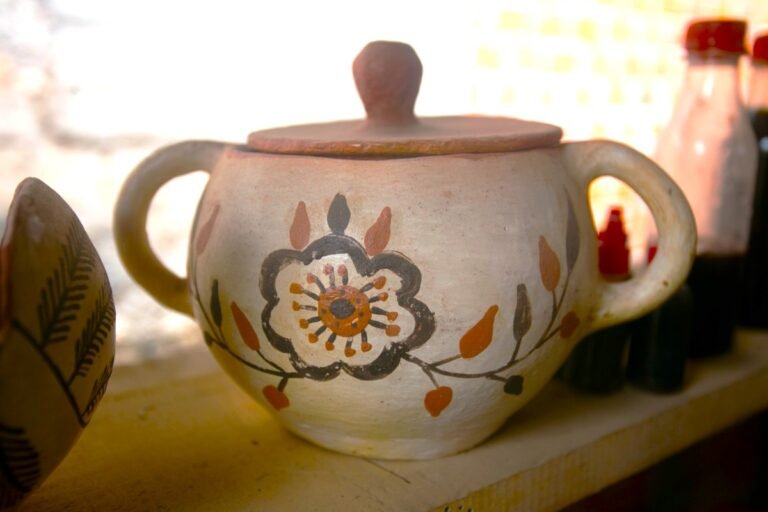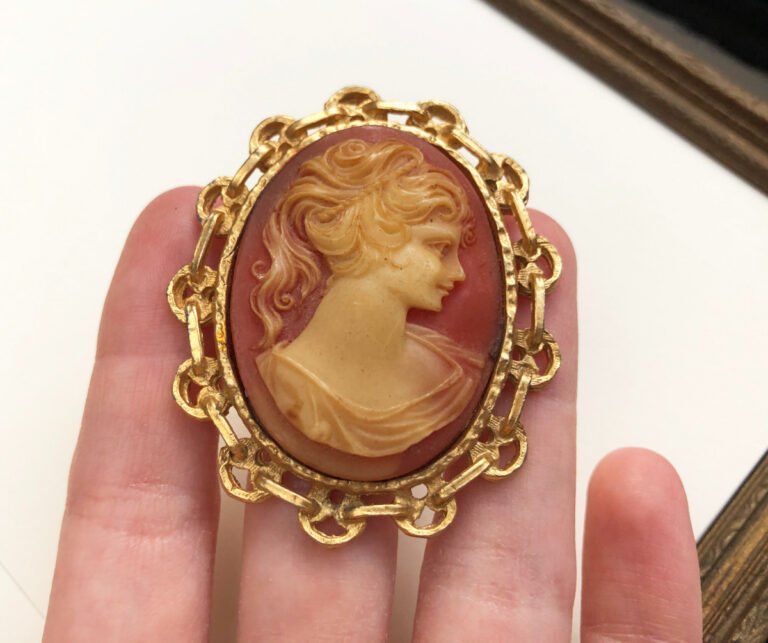Porcelain dolls are easily one of the most nostalgic antique toys, especially for women. But these weren’t just toys! They were made with high-quality materials and unmatched skills, becoming more like a piece of art, an art that you don’t get to see today.
That’s why Rare Jumeau, Bru, and Kestner dolls have been selling for thousands at auction. If you have an old porcelain doll, this guide will help you check whether it’s a valuable antique or just an old toy!
Why Are Old Porcelain Dolls Collectible?
Porcelain dolls began in Europe around the 1840s as a result of a competition between Germany and France for power and craftsmanship.
Initially, dolls were created to represent the high-class ladies of that time. With time, various other styles developed in different areas, like the French fashion dolls with Parisian styles or the German child dolls.
Crafters also made character dolls with more expressive designs and ethnic diversity. All these pieces now offer a glimpse into the exceptional craftsmanship and cultural values of the past; no wonder collectors buy these dolls for thousands today!
How to Identify Your Antique Dolls?
To identify a real antique porcelain doll, it is important to closely look at its key features, like materials, markings, or artwork. This way, you will be able to authenticate the pieces and avoid counterfeits.
Here are the top 7 key signs to look for to know whether your old porcelain doll is antique or not!
1. Important Markings
The most reliable feature for identifying these old dolls is to examine the markings. You will find them either on the back of the head, shoulder, neck, under the arm, torso, or even on their apparel.
These markings often display the manufacturer’s name, their logo, mold or model number, and sometimes even the country of origin.
Some of the most renowned makers are:
- Armand Marseille: The dolls from this maker would be marked as“Armand Marseille”, “A.M.” or “Made in Germany”. Also, look for mold numbers like 390, 370, 341 on them.
- Kammer & Reinhardt: Known for character dolls, their signature mark is “K*R, Kammer & Reinhardt” mostly with mold numbers like 115A and 117.
- Simon & Halbig: A well-known maker and supplier of doll heads. “S&H, Simon & Halbig” is their official mark, but if you find a mold number with it, like “Simon & Halbig 1079,” then it’s highly desirable.
- J.D. Kestner: The famous ‘Googly doll’ is made by them. Collectors recognize Kestner for their high-quality bisque heads and bodies, which may feature marks such as “Made in Germany,” “J.D.K,” and mold numbers.
- Gebruder Heubach: Their signature mark is a ‘Rising sun symbol’ or “Heubach” with mold or model numbers.
- Bru (Bru Jne. & Cie): A French company that is widely known for its expressive doll face. Look for marks that state “BRU Jne”, “BRU Jne R” or “Bébé Bru”.
- Jumeau: Highly known for the fashion doll collection, their top pieces have marks mentioning “Jumeau,” “E.J.,” “Depose Tete Jumeau Bte SGDG,” “BG.F,” and “B9L”.
- Alt, Beck & Gottschalk (ABG): Widely sought for their molded hair and china heads, these dolls will have marks of “ABG, “A.B. & G” along with mol numbers.
- Gebruder Kuhnlenz: Their brown complexioned doll is highly attractive. These pieces have mold marks, like 34-18, 35-27 on them.
- Schonenau and Hoffmeister: Popular for their Princess Elizabeth doll, their pieces have marks of “S PB H” with mold numbers.
If you come across a doll with a different maker mark or no mark at all, then no worries at all, just look for other key identifying features below to know more.
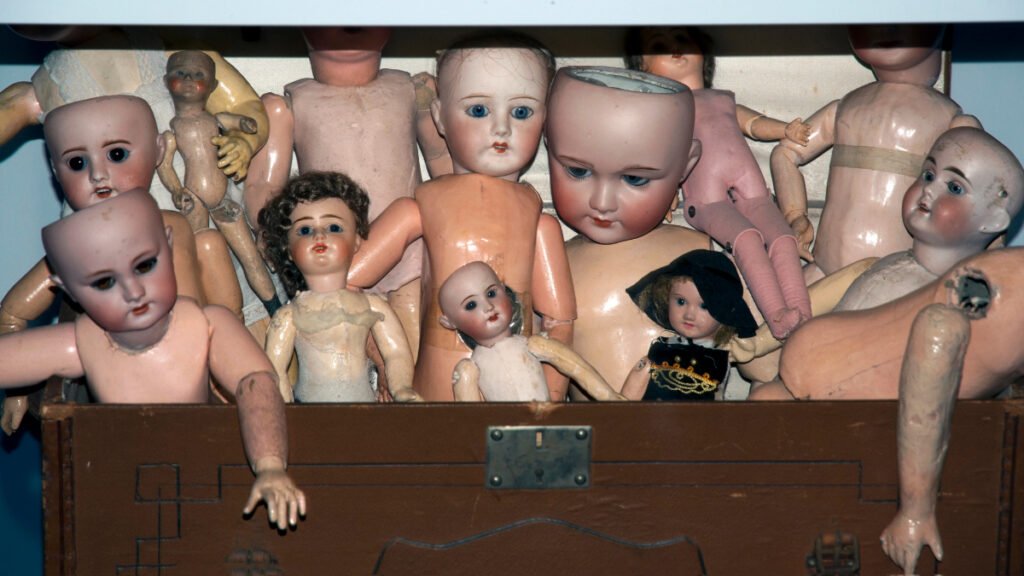
2. Material (Head & Limbs)
Regarding the material used for old porcelain dolls, craftsmen primarily used two types of porcelain for the head and limbs. Understanding these compositions will help you spot antiques from the remakes.
- Glazed Porcelain – Many earlier dolls, especially those crafted before the 1860s, often feature china-glazed porcelain for their heads. This gives a shiny finish to the pieces, making them glow.
- Unglazed Porcelain – This type has a smooth, matte finish. Dolls that were made post-1860s used this material. Artisans used to hand-fire and paint these e bisque, resulting in unique tonal variations from that of a glazed one.
3. Body Construction
Although the porcelain heads and limbs remained consistent, the body construct materials of dolls varied with time. Understanding this will help you identify as well as date your dolls. The different types include –
- Composition Body – In the 1800s, craftsmen used to create the doll’s body using a mix of pressed compound made of sawdust, glue, and resin. This was a popular usage, and it also indicates the doll’s original age.
- Kid Leather Body – This type generally has stuffed leather, often with jointed limbs and a bisque or china head.
- Wooden Body – Early dolls, especially from the 18th to early 19th centuries, had carved or jointed wooden bodies. Look for visible peg joints and hand-carving to spot these.
- Cloth Body- This soft, stuffed fabric body usually pairs with bisque or china heads. Their hand-sewn seams and stuffing like sawdust or horsehair will help you date the doll.
4. Facial Features and Hair
You will find antique porcelain dolls with distinct facial features, such as glass sleep eyes that open and close, open mouths revealing teeth, multi-stroke eyebrows, blushed cheeks, and finely molded noses and ears!
As for the hair, old dolls generally have colored hair made of mohair or human hair wigs glued to their heads. Original wigs significantly hint at antique piece, unlike synthetic ones that are modern.
5. Clothing and Accessories
Original clothing provides vital clues about a doll’s age and nationality. For example, French fashion dolls flaunted elaborate dresses made of silk, lace, or velvet, often reflecting the adult fashion trends of their era.
On the other hand, German child dolls wore simpler, period-appropriate outfits. You can easily see the difference in the clothes.
A doll is incomplete without its accessories. Look for details like parasols, bonnets, and original boxes that further enhance a doll’s authenticity and value.
My Tip: Look for hand-sewn seams, vintage buttons, and leather shoes made of natural fibers to spot antique pieces.

6. Painting
Genuine old porcelain dolls will have hand-applied paint, so it should show subtle variations in lip color, eyebrow shape, and blush placement. The painting is soft and well-layered, making the dolls look true-to-life.
7. Weight and Proportions
Weight can help you identify a real porcelain doll since these are heavier than modern remakes. The significant weight also tells you about the usage of original high-end materials and not light plastics.
Moreover, look for the proportions and uniformity in its features. A more realistic-looking doll with a good body-to-face ratio is more authentic. Some models may even exhibit charming “bent limbs,” giving a human-like effect.
How to Know the Value of Old Porcelain Dolls?
Now that you know what a real antique porcelain doll is, it is important to understand that not every doll you spot will have the same value. The real worth varies because of many factors, such as:
1. How Old Is It?
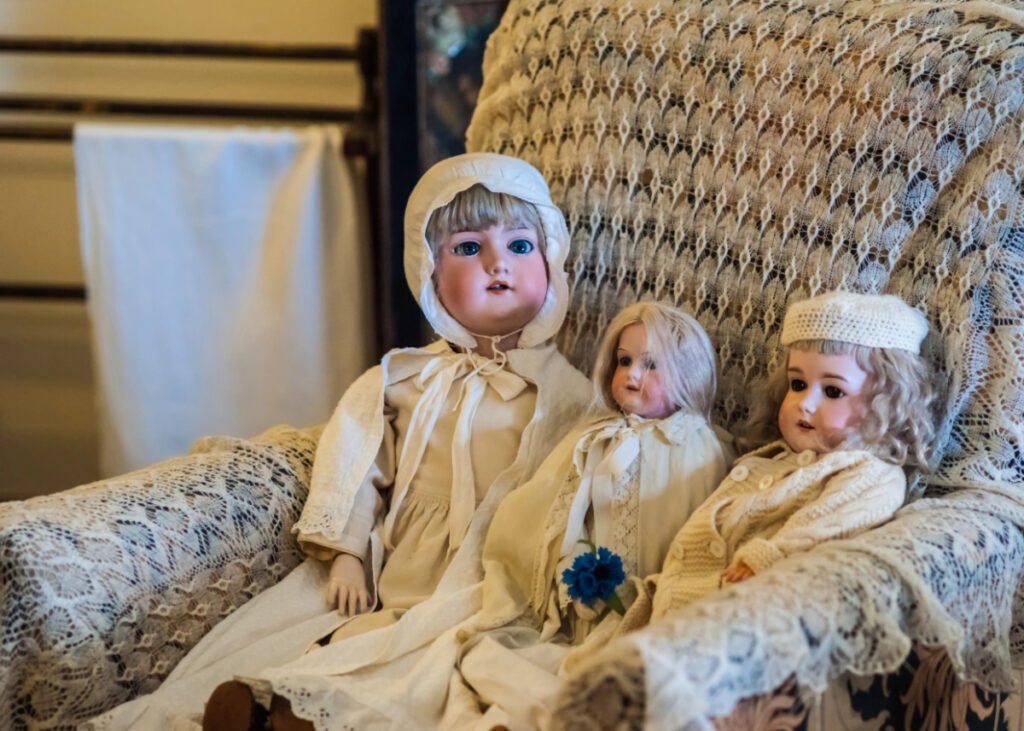
For dolls, the older the better, particularly those from the 1800s to the early 1900s. The reason is very simple: antique dolls from this era were often crafted with high-quality detail, such as bisque, kid leather, mohair wigs, and hand-blown glass eyes.
Some of the early examples also feature rare construction techniques and maker’s marks from renowned manufacturers like Jumeau, Kestner, or Bru. Since the old and original factor is there, the value of such pieces is high.
2. What Condition Is It In?
Just like age, the condition of a doll is equally important since no collector would want a damaged item for a high price. So, take note of the following conditional factors to estimate the price –
- Cracks, chips, and crazing: Dolls in near-original, undamaged condition always fetch higher prices than those with visible wear, cracks, or repairs.
- Paint Wear: Loss of facial paint, especially around lips, cheeks, or eyebrows, often devalues a doll.
- Unrepaired Dolls: Original dolls that didn’t go through any retouching or repair retain more value. Even if the repair was done, it should not reflect any visible amateur work.
- Wig and Hair: Dolls that still have the original wig made of hair and mohair intact are preferable instead of the synthetic replicas.
- Body integrity: A porcelain doll’s body is equally important as its face. Missing limbs or joint issues can give a bad remark.
3. How Rare Is It?
Rarity refers to uniqueness, be it for fewer pieces or unusual lineups. This helps in the collection of exclusive pieces, and that makes them significant.
The signs that make a porcelain doll rare are:
- Limited production runs: The dolls that were made in small batches or for special occasions are considered rare. These dolls generally have a specific look, skin color, or thematic style, meaning they belong to a specific line.
- Discontinued models: There were a type of dolls that are no longer in production, especially from the short-lived lines or collections. The two-faced dolls or the half dolls are from that few.
- Uncommon features: Dolls that have additional uncommon features are treasures. Some features are musical elements or in-built voice boxes, and rotational or flexible body parts.
4. Is It a Complete Piece?
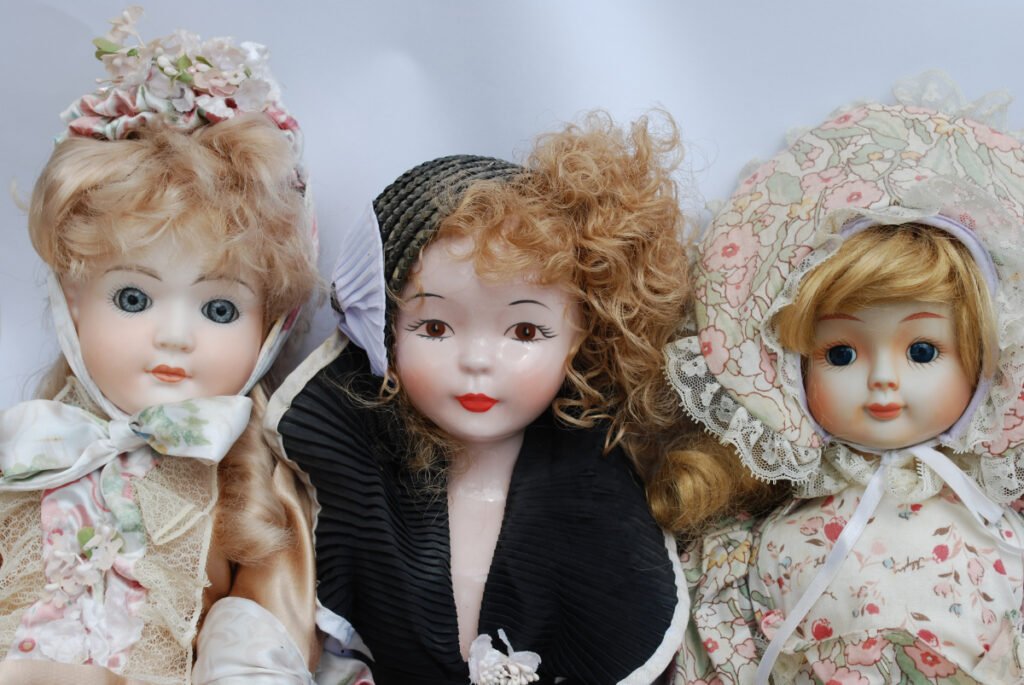
Even the mass-produced antique dolls can become highly valuable if they are complete or retain their original accessories. So, look for these:
- Matching apparel: Ancient dolls were made of real clothing and accessories like hats, ribbons, purses, etc, with matching colors and patterns; these are hard to find in uniform sets, that alone in good condition.
- Packagings: If the doll has its original packaging and the box, then it is a valuable, authentic piece. Some even come with cards, paper, and other inserts that raise collectors’ interest.
Completeness is rare, as these are century-old dolls and most items are lost. So, if you find a complete piece, you could be lucky!
Also, complete doll sets, like a whole doll family, can be highly valuable compared to single pieces.
5. What Size Is It?
Collectors often consider the size of an antique doll along with its visual appeal. The average size of dolls was between 16 and 20 inches, and anything larger (or significantly smaller) than that is rather rare.
But a china doll can range from as small as 1 inch to more than 30 inches tall, and a bisque doll can even go up to five feet in some cases, making those highly rare.
But small miniature dolls under 6 inches, like the Frozen Charlotte and the Mignotte dolls (often made for dollhouses and decorations) are highly desirable due to the efforts made by the artisans to make small details!
Note: Though the value will largely depend on what doll size a collector prefers, these general ideas will help you assess an average value.
6. Who Made It?
As certain makers from that era were well-known manufacturers, their name and reputation impact a doll’s price. For example, dolls from makers like Jumeau, Bru, Kestner, Simon & Halbig are highly prized because they are like the pioneers of Fashion dolls.
Also, high-end makers could afford superior materials, creating high-end dolls. Their bisque dolls are always structured, and the artistic work is professional throughout.
So, ensure to check the marking on the doll’s back to check who made it!
7. Is It Documented?
Last but not least, a doll with proof of evidence, like certificates or receipts, is like an asset. It not only provides authenticity but also helps in referencing the doll’s age, features, or any repairs that were undertaken.
Here are the things to look for:
- Original box
- Sale receipts
- Certificates (with doll name, brand, line, etc)
- Provenance records & photographs
- Any appraisal certificates (if appraised)
- Repair & restoration records (if restored)
12 Super Rare & Valuable Antique Porcelain Dolls Worth Finding!
Now that you know how to spot real porcelain dolls and assess their values, take a look at some rare examples that are ACTUALLY valuable!
1. French Bisque BeBe Doll by Jumeau
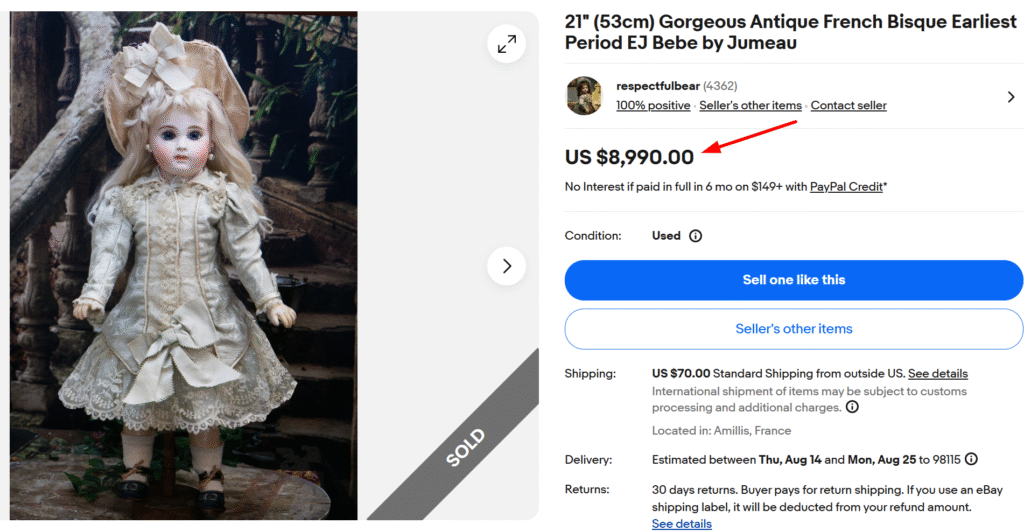
- Maker: Eden Bebe by Jumeau
- Marks: Jumeau, Emille, and Paris
- Origin: France
- Type: Child Doll
- Size: 21 inches
- Era: 1880s
This beautiful French porcelain doll by Jumeau, from his famous “Bebe collection,” is one of its finest. It’s made of bisque and has 8 wooden ball joints for the body.
The delicate blonde hair on these dolls generally uses real mohair. You can spot Jumeau’s characteristic soft, distinctive brush strokes on the face, making this doll more human-like. Truly a piece of art, rightly sold for a stunning price!
2. Simon Halbig Mein Liebling German Doll
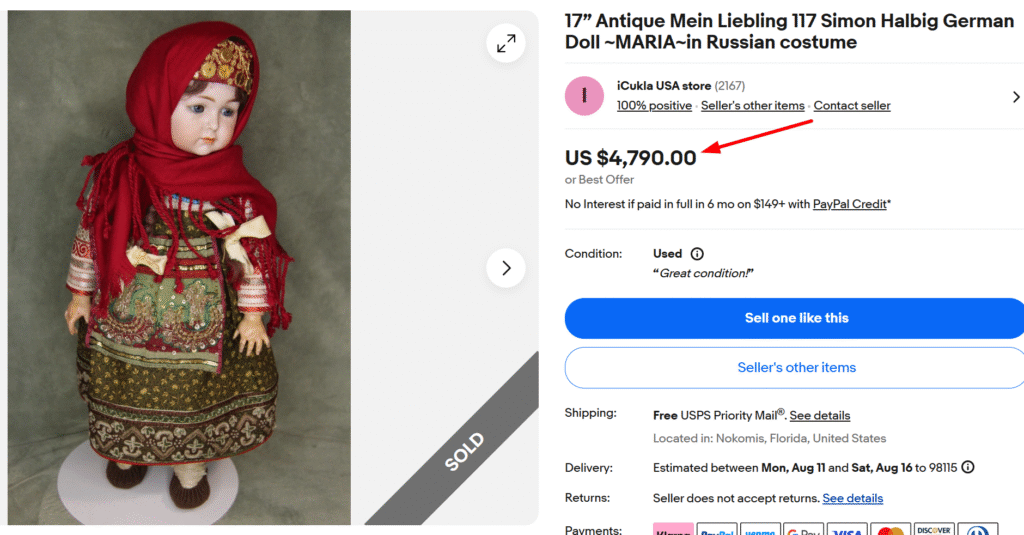
- Maker: Kammer & Reinhardt , Simon Halbig
- Origin: Germany
- Type: Character Doll
- Material: Bisque, Composition
- Size: 17 inches
- Era: 1900-1919
This charming antique girl doll named Mein Liebling, meaning “My Darling” in German, was crafted by two big names in the ancient doll industry: Kammer & Reinhardt and Simon Halbig.
Since it’s a character doll, you’ll find it with a traditional Russian costume and accessories. It also features clear maker’s marks and a mold number ‘117’, proving its authenticity and adding value.
3. Bebe Bru Jne Doll with Composition Body
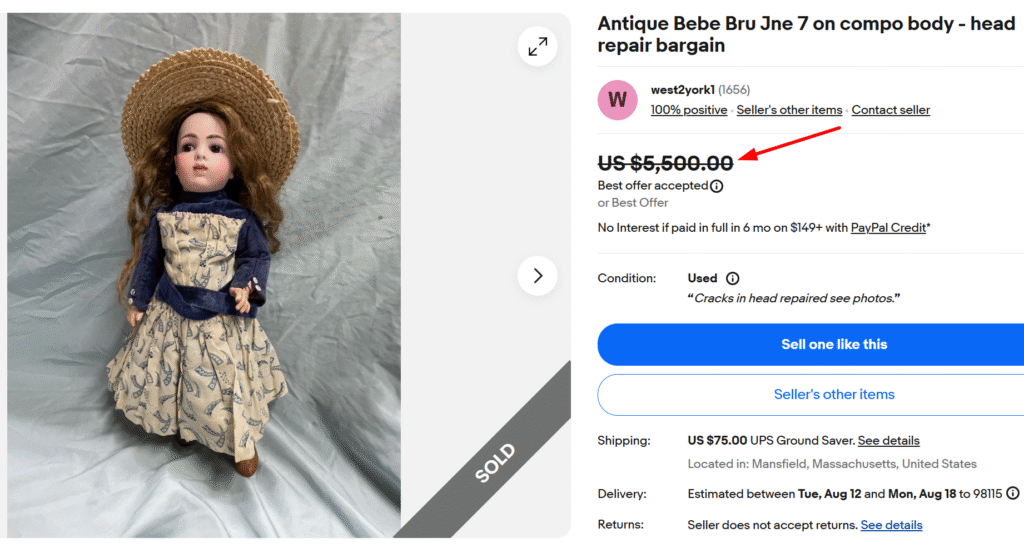
- Maker: Bru, Jne & Cie
- Origin: France
- Type: Girl Doll
- Size: 17 inches
- Material: Bisque & Composition
- Era: Pre 1900
The Bebe doll is one of the finest collections of Bru Jne. With original paperweight brown eyes and a light brown human hair wig, the doll looks like a real French girl with Caucasian ethnicity. Such character dolls with specific ethnicities are highly sought-after, evident by the eye-popping value this piece sold for!
4. Rare 1870s French Poupee Fashion Doll
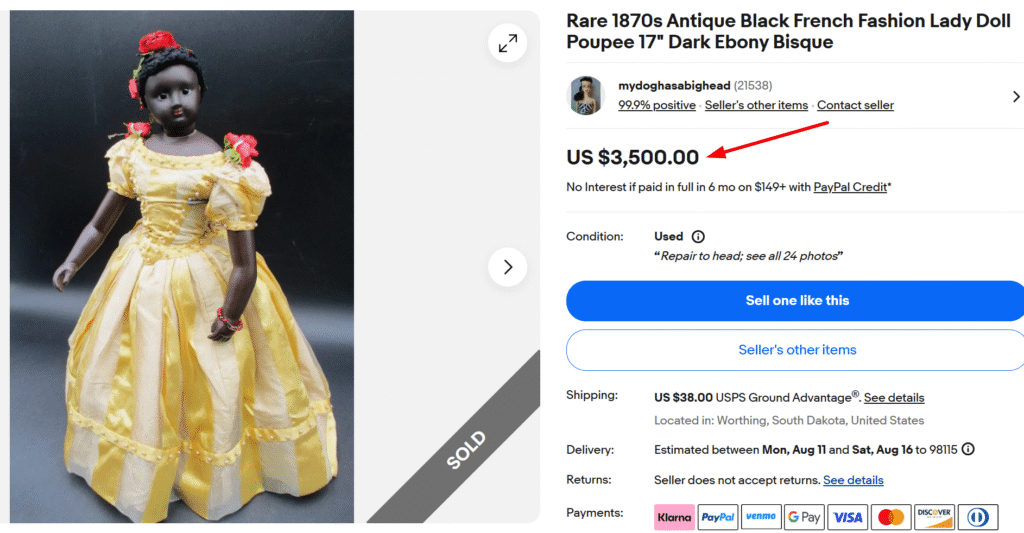
- Maker: Unmarked
- Origin: France
- Type: Fashion Doll
- Size: 17 inches
- Material: Bisque, Kid Leather
- Era: 1870s
This stunning French Ebony bisque doll from the 1870s is a rare piece because of its unique dark skin color. It’s dressed in a gorgeous yellow cream period gown with red floral decoration in her lambswool wig. Culturally themed dolls were uncommon at that time, making these collectible.
5. Bahr & Proschild Closed Mouth German Doll

- Maker: Bahr & Proschild
- Origin: Germany
- Type: Girl Doll
- Size: 15 inches
- Material: Wood, Composition, Bisque
- Era: Pre-1888
This Bahr & Proschild German Doll is a collectible example from the late 1800s. It has a unique, delicate bisque head, with brown glass sleep eyes, and a closed mouth, a less common feature that boosts the value!
These dolls are usually made of a jointed wood and composition body, often marked with mold numbers like 204 or 252 and a size number on the back.
6. Kling China Doll

- Maker: C.F. Kling
- Origin: Germany
- Type: China Doll
- Size: 13 inches
- Material: Bisque
- Era: 1890s
Created by C.F. Kling from Germany, this all-bisque doll is from one of the rarest collections of “China Doll.” The sculpted hair that you would see is a key feature that differentiates it from others.
Additionally, the apparel covering the boy is an original cotton dungaree, which complements the toddler look. The cap and teddy bear are additional accessories, which, if found, can make this doll valuable.
7. German Dream Baby Armand Marseille Doll
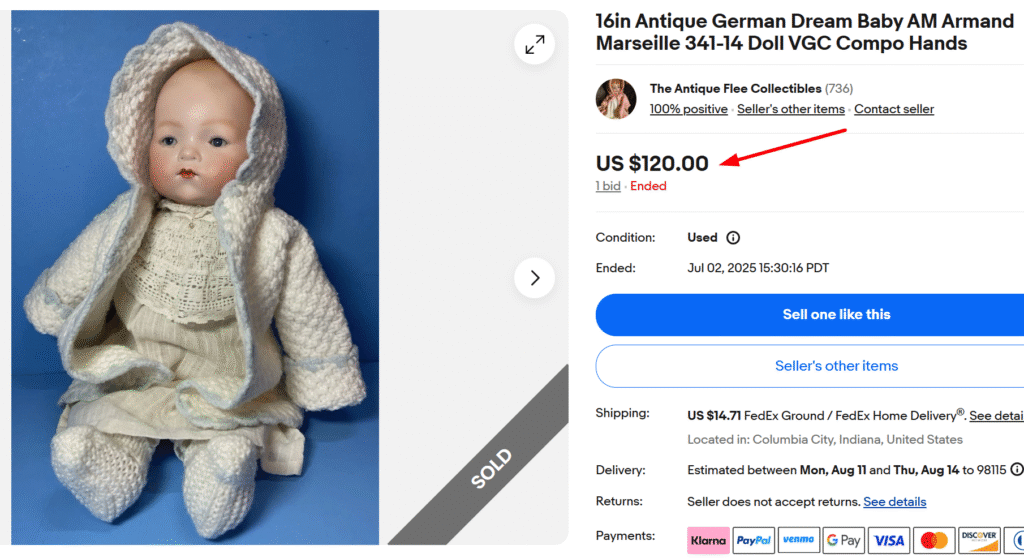
- Maker: Armand Marseille
- Origin: Germany
- Type: Baby Doll
- Size: 16 inches
- Material: Cloth and China/Porcelain
- Era: 1920s
This is an almost 100-year-old baby doll from the Armand Marseille collection. With its nimble hands and sturdy cloth, the doll looks like a living child. Some original Dream Baby Dolls also had a voice box inside their bodies. If you find one with a working voice box, it can be a great deal.
8. Simon Halbig Fashion Doll
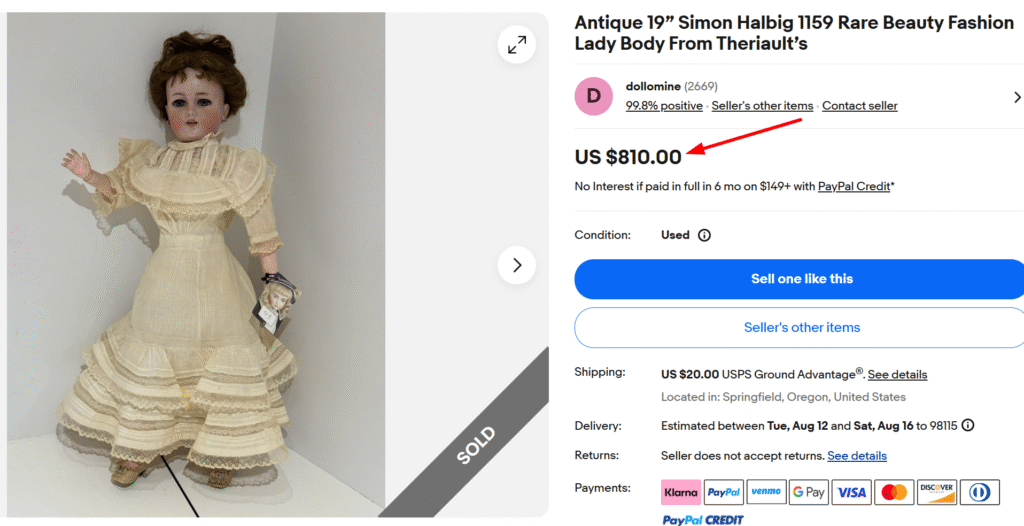
- Maker: Simon Halbig
- Origin: Germany
- Type: Lady Doll
- Size: 19 inches
- Material: Bisque
- Era: 1895
A gorgeous lady doll crafted by the well-known Simon and Halbig. It features the mature face of a high-class woman with elegant makeup and a vintage dress. Apart from original markings like “1159” and initials on the back, the well-sculpted bisque heads and life-like details make these dolls valuable.
9. Wagner & Zetsche Character Doll
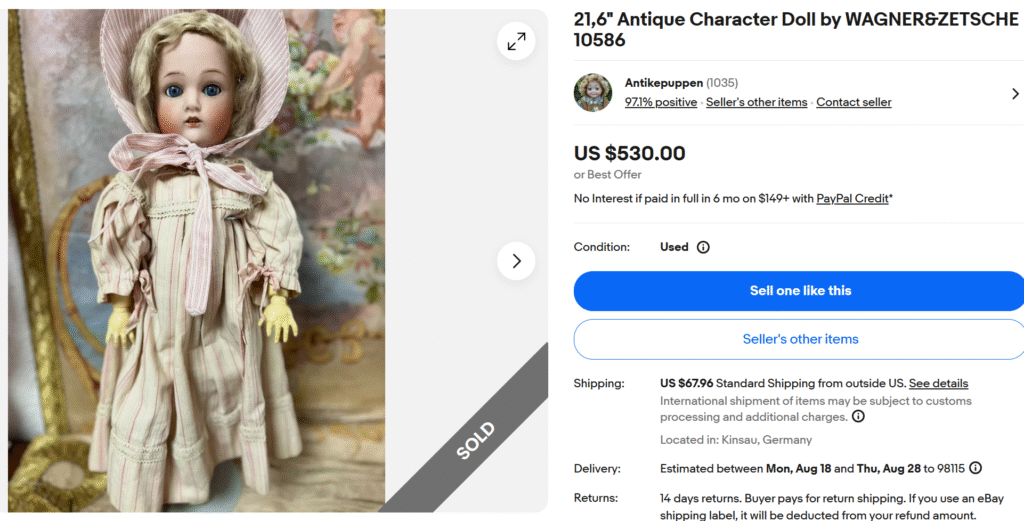
- Maker: Wagner & Zetsche
- Origin: Germany
- Type: Character Doll
- Size: 21.6 inches
- Material: Bisque, Composition
- Era: Early 1900s
Wagner & Zetsche is literally known for their character dolls. This massive 21.6-inch example features the Heubach mark with the initials W. u. Z. on the back of the head. You’ll also find features like sleepy eyes, well-painted faces, and a vintage wig on these pretty dolls!
10. Kestner Googlie Doll Set
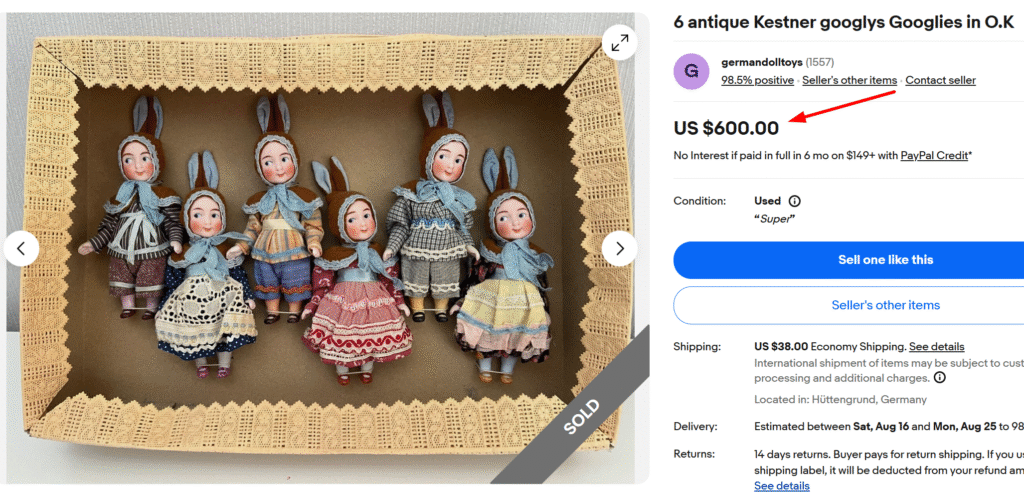
- Maker: Kestner
- Origin: Germany
- Type: Googly Dolls
- Size: 4.5 inches
- Material: Bisque
- Era: 1900-1920
A rare set of googly-eyed dolls by Johann Daniel Kestner, who is known for his googly doll work. You can easily spot these by their wide, side-glancing glass eyes and jolly expressions.
The arms and legs of the dolls are joined with movable wires at the back. The original collection comes in its distinctive lace packaging, with a ‘Made in Germany’ mark!
11. Shoenau & Hoffmeister Musical Rotating Bisque Doll
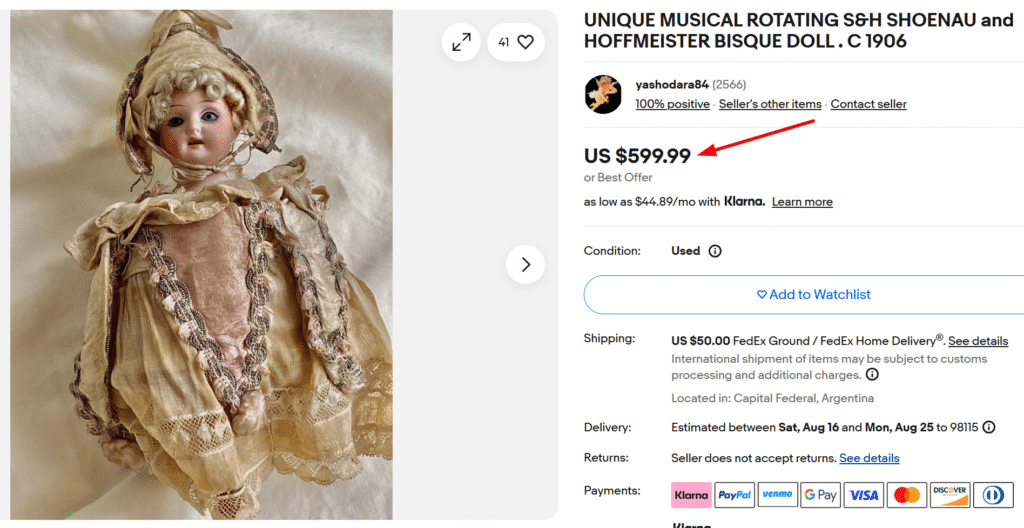
- Maker: Shoenau and Hoffmeister
- Type: Rotating Musical Doll
- Size: 17 inches
- Material: Bisque
- Era: 1906
This unique bisque doll by Shoneau and Hoffmeister is one of the exquisite pieces from the early 1900s. It has unique features like a rotating body (on a stick) and a musical mechanism, which were not common back then.
The doll features period-correct clothes with lace and ribbons and mohair wigs. The back shows the “S&H” marking along with a star motif and mold numbers!
12. Cuno & Otto Dressel “Jutta” Toddler Bisque Doll
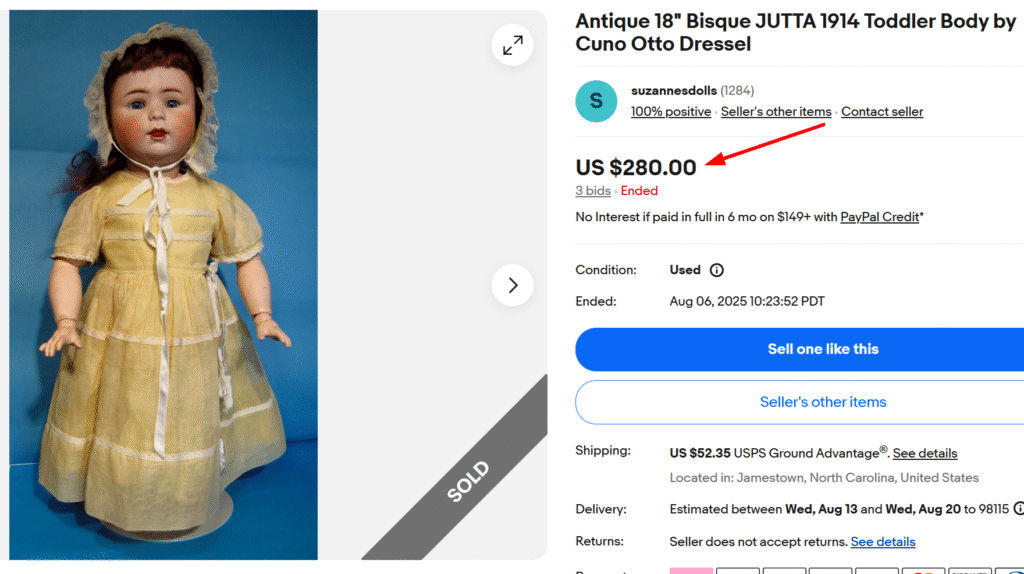
- Maker: Cuno & Otto Dressel
- Origin: Germany
- Type: Girl Toddler Doll
- Size: 18 inches
- Material: Bisque, Composition
- Era: 1914
This beautiful 1900s doll is from the famous “Jutta” collection by Cuno Otto Dressel, Germany. Along with well-painted eyebrows & blue eyes, the doll has an open mouth with visible tongue (not many pieces have that), giving it a lifelike childish look, a defining feature of the Jutta collection!

